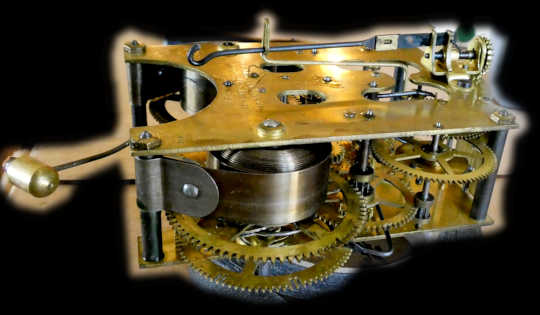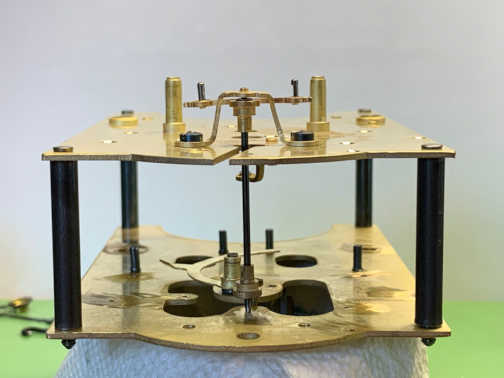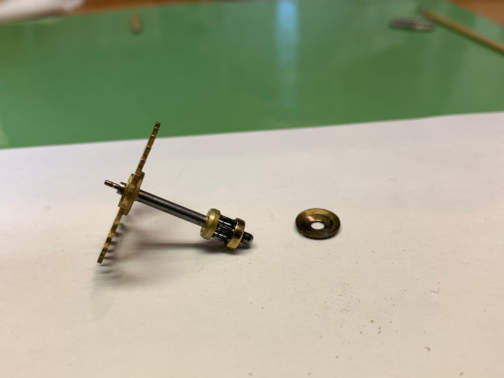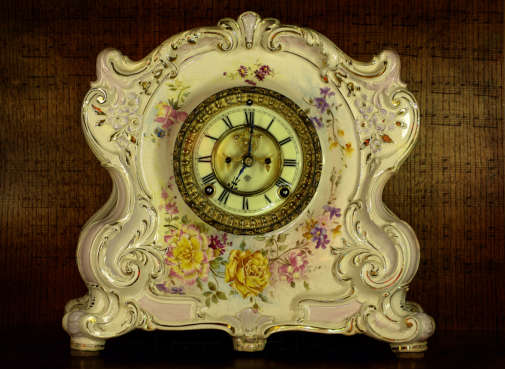It was the middle of the night and I woke up to the sounds of Vivaldi’s Concerto for Cello in G Major.
Now, I’m an ardent fan of Vivaldi’s orchestral compositions (his operas, not so much). But being awakened in the middle of the night by anyone’s music is not a good thing. Especially when the source of the music is a mystery. And even more especially when it sounds like it is my wife’s mother playing the cello. She was a professional musician but she’s been dead for years.
The music stopped as I was waking up so obviously I had just dreamed it. The strange part, though, is that was the night our antique clock stopped working. And stayed stopped. Nothing I did the next day worked to get it going again.
This antique timekeeper has been in my wife Chris’s family since the clock was new in 1906, eventually handed down to her mother, then after she died, to Chris.
The clock had been having more and more problems since we inherited it and this final episode of quitting meant it needed repair. But where do you take an antique clock to be fixed in this throw-away society, especially when almost everything is digital?
It turns out there are lots of horologists – people interested in watches and clocks, and those who fix them. A Google search for “clock repair madison wi” turned up several in our area. The most impressive looking one was for Brumley’s Old Clock Shop, in business at the same location for fifty-some years. The owner’s name was Lee Brumley and there were six ratings with comments on his Yelp site.
The comments said laudatory things like, “the very kind and knowledgeable owner,” “his reasonable rates,” and “You will not find a more honest and helpful storekeeper in all the land.” To all of which my response (now) is, bullshit!
The one not-so-laudatory comment (two star rating) I should have paid attention to was an articulate piece of screed by one Jenny Z.:
Ok so I went to Brumley’s yesterday….and as it turns out, my clock wasn’t even broken. However, before this embarrassing fact got out, I was pretty much appalled at the miserable crabby old man act that the owner had going on. I don’t appreciate being treated like an idiot….although maybe he could tell I was an idiot if I brought a working clock to a clock shop to get fixed. Either out of shame or annoyance, I won’t be back!
But I didn’t heed the implicit warning in her message. Instead I let myself be influenced by the other oh-so positive comments and took the clock to Brumley. He told me the clock needed to be completely rebuilt, it would take about three months, and it would cost around $400.
While I was there in his tiny little shop in Madison I noticed that his tools — a small lathe, drill press, and others — all looked dusty and unused. I should have paid more attention to that, too.
Instead I left the clock with Brumley for what I thought was going to be a three-month, $400 project that would bring my wife’s clock back into fine fettle.
Wrong again! We were without the clock, which is to say Brumley was “working” on it, for eleven months and two weeks. Two weeks shy of a year! And the charge was $501.15. That’s more than 25 percent above Brumley’s original estimate.
When I got the clock home I noticed that every one of the nine mounting screws were quite loose. What the . . . ? How does something like that happen, especially when the work was allegedly done by a pro? It was no big deal for me to tighten the screws but it troubled me a lot. Those loose screws were actually an appropriate metaphor for my eventual assessment of Mr. Brumley’s work. And his mentality.
The clock ran just so-so. There were some disappointing aspects to its performance. For one thing the chime hammer was loose. When it chimed the hammer would occasionally miss the gong or hit it askance and produce a muffled thud. That was particularly annoying because the clock’s chime is one of Chris’s favorite things about the clock.
Then there was the occasional thunk. Every once in a while, at random times, the clock would make a fairly loud thunk. We never figured out the cause of that noise.
The clock ran somewhat regularly for about a year after coming home from Brumley’s, but then it started getting erratic in its time keeping. It got worse and worse over the succeeding months and finally became totally psychotic in its behavior. I came to think of it as the Brumley syndrome. It was impossible to get the clock to keep anywhere near accurate time for more than a few days at a time. Sometimes it would speed up, sometimes it would slow down. And from time to time (!) it would just stop for no apparent reason.
Chris did not appreciate it when I opined that the spirit of her deceased mother had taken up residence in the clock. (For that I had to do ten Hail Fairies. That’s not a typo; we’re not Catholic. We’re not even Irish. It’s just that fairies are cool.)
Then one day, this time sans cello moans or any hint of Vivaldi, the clock just up and quit. Rolled over and played dead permanently. Again. Two years after we paid $501.15 to Brumley to “rebuild” it. That’s $250 a year for a clock that originally cost $16.50 (in 1906). (Not particularly relevant, I know, but I couldn’t resist making the comparison between the clock’s original cost and what I paid Brumley for what was at best a temporary fix. I would learn later that not only was the clock not correctly fixed, it had actually been damaged. More about that shortly.)
So it was back to the drawing board in an attempt to find an honest, reliable, good clock fixer.
I list honesty first because I don’t want any more truck with the likes of Brumley. Did he knowingly, cynically cheat me? I’ll never know, but I have my suspicions.
Reliable. If someone tells me he can fix the clock in a certain period of time for an amount of money within a reasonable range, I expect that to happen.
And then there is good. Being “good” at something is complicated; its like art, we know it when we see it.
I was going to have to employ some perceptive interaction and acute observation to avoid ending up with someone else like Brumley. Not exactly my forte.
With him there had been two signs I should have heeded.
First, which I’ve already mentioned, was the state of his workshop. The tools looked like they had not been used in a long time. And there was junk everywhere. Clearly there was no work going on in this workshop. I thought maybe he did the actual work somewhere else to avoid interruptions. But when I asked him if he did all the work and he did it “here,” meaning in his storefront shop where we were, he said yes.
So that was the first sign I, like an idiot, chose to ignore.
The second sign was the interaction I witnessed between him and a young couple who came in with what was clearly an inexpensive, battery driven wall clock. Brumley turned to them when they came in and brusquely asked, “What do you want?” He had not been particularly nice or diplomatic with me, but I was shocked by his rudeness to them. They mildly demurred and left.
Yelp commenter Jenny Z referred to the “…miserable crabby old man act that the owner [Brumley] had going on.” I don’t think it is an act; I believe he is a genuinely miserable and crabby old fart. Being older than he, I can get away with saying that.
Like I said, I should have listened to my gut and kept looking for another clockmaker. But I did not. My bad. I would try to not make that mistake again.
Even a brief search on the internet turns up countless people who call themselves horologists. I found many of them, in my estimation, to be clearly disreputable. Some are simply amateurish dilettantes. Most showed no signs of having put in the arduous time and effort required to be good at clock repair.
That ten-thousand-hours thing comes to mind. You know, that it takes 10,000 hours to become really good at something. That’s about five years at 40 hours a week. Maybe that’s enough for some things. But I know from my first career as a classically trained concert clarinetist that most people cannot get to Carnegie Hall in just five years.
So, having been burned once (Brumlyed, let’s call it) it was obvious that I was going to have to kiss a lot of frogs, as the girls in my youth used to say about finding a prince.
I formulated the following strategy as an effort to find a princely clockmaker:
- 1. Search the internet for convincing web sites offering clock repair.
- There are lots of canned formats for clockmaker web sites. Many of the less capable looking horologists put up a site then evidently never look at it again. These canned sites all say pretty much the same thing – larded with brochure blather and empty cliches — and tell very little about the person’s actual qualifications for fixing clocks. There might have been some capable clockmakers lurking behind these sites but I moved on, not wanting to waste my time.
- 2. Look for web sites with pictures of the clockmaker’s shop and work area.
- Thinking of Brumley’s cobwebbed and dusty work area I wanted to see a work area that looked professional and used. Messy would be fine, preferable even. But very few of the canned sites I saw offered even slightly promising pictures.
- 3. Once a prospective — which is to say, promising — web site is found, communicate via email or the website’s messaging function.
- State the problem, describe the clock, and include a photograph of our clock’s internal workings. I had removed the clockwork from its housing and taken pictures of it. Ask if they a) were familiar with this kind of clock; b) their work schedule; and c) did they work by mail. That is, could I send them the clockwork to fix, then they send it back to me when it was finished.
- Once they answered I would ask: a) where did you learn to fix clocks? b) how long have you been at it? c) how do you charge and what is a range of cost (i.e., how much to look at the clockwork and give an estimate, how much to return the clockwork without working on it if that is my decision, and probable highest cost if the clock needs complete rebuilding?)

A surprisingly large percentage of my queries went unanswered, and the answers I did receive on initial contact were all over the map.
Questions about qualifications and personal history are welcomed by craftspeople who have worked hard and are proud of what they have accomplished. They invariably relish the opportunity to talk about such things. But those who are faking it tend to get pretty snippy about what for them are embarrassing questions. Usually they just clam up and refuse to respond..
A few of the clock fixing people said send them the clockwork to look at but when I asked them how much that would cost I never heard from them again. Even after I re-sent my message (twice, in one case).
I had been right in my original conjecture. I was having to kiss a lot of frogs.
All my frog kissing finally brought me not to a prince but a princess, as it were: Karyn Critelli at the Village Clock Shop. Her website is professional without a lot of corporate gloss and contains a heap of information. Her training history is impressive and from her website I strongly felt that this was a woman who knows her stuff.
I shot off my by-now standard first email to Karyn and she answered it within minutes. After another couple of emails I decided to take the clock to her to fix. We didn’t have to do the mail-the-clockwork thing because her shop is only about an hour’s drive from us.

Within a few weeks Karyn had the clock fixed, although it had taken her longer than she originally thought it would because some weird things had been done to the clock.
She told me it had “…been abused in numerous ways … I can’t imagine who would do what was done, but clearly whoever it was got in over their head and never stopped. It surprises me that it ran for you at all in the condition it was in.” She gave me some pictures from when she was working on it.

The “whoever it was,” I’m pretty sure, was Lee Brumley of the Old Clock Shop in Madison, Wisconsin. (See above.)
Here’s what I think happened with Brumley. I can’t prove it of course but I believe he either sent the clock off to some sweatshop-like clockmaking enterprise (China? Hong Kong? Alabama?), or has some inept local amateur who does the work. This is speculation on my part but it is hard to believe that anyone who has been at it as long as he says he has could be so inept. My thinking is that he might have turned the clock over to whomever, paid them, say, $100 and charged me $500.
At any rate Karyn got the clock chiming healthily and working like new. After her ministrations this 118 year old clock now keeps excellent time. It does not speed up or slow down every few days like it did (just before it stopped running altogether, that is). The chime does not skip and the sound is more sonorous than it was, due I’m sure to a proper alignment and spacing of the striker/hammer/whatever it is called.
There is a very mild form of post-traumatic stress disorder (PTSD) that develops from the kind of unpleasant experiences we’ve had trying to get this clock fixed. Like checking first thing every morning to see if it is still running. Listening attentively every time the clock chimes to see if the hammer misfires. And checking the time of the chime against cellphone or computer time to see how slow or fast the clock is.
Now, several months after getting the clock back from Karyn, I’m happy to say those PTSD symptoms are clearing up. I confess to occasionally listening to the chime and checking the time, but now it is to revel in the inerrant quality of the chiming and the fact that the time is dead on. Nice.
One more thing I want to mention about Karyn Critelli and her Village Clock Shop. It is no secret that today in America being a consumer has become mostly unpleasant. Customer service is largely inadequate where it exists at all, profit gouging has boosted the price of everything into sticker shock territory, and quality control has slipped enormously.
For these and other reasons I particularly appreciate it when I am treated with courtesy and consideration by anyone selling anything. Karyn went beyond this and was always honest, considerate, and very courteous. And timely. I never had to wait long to hear back from her with email or a text message.
One word of warning, though, if you contact Karyn. Don’t crack any dumb jokes about clocks or dogs. She is passionate in her love for both and does not suffer fools lightly. (Don’t ask how I know that.)
I included above a link to Karyn’s website. Here it is again: villageclockmaker.com.
Disclaimer: I have no affiliation with Karyn Critelli or the Village Clockshop. I’m just a satisfied customer, which is saying a lot these days.
